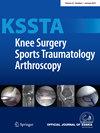Resident participation does not affect outcomes or complications after arthroscopic Bankart repair surgery
Abstract
Purpose
We performed a retrospective cohort study to assess the impact of resident participation on Bankart repair surgical outcomes over a 2-year mean follow-up period, by comparing clinical and patient-reported outcomes (PROs) between surgeries primarily performed by residents in training and those primarily performed by fellowship-trained attending shoulder surgeons. We hypothesised that there would be no difference in outcomes between the two groups.
Methods
All consecutive patients who underwent primary arthroscopic Bankart repair surgery for shoulder instability over a 4-year window in our institution were included. They were divided into two cohorts depending on whether they were performed primarily (>75% of the cases) by residents or attending surgeons. Standard preoperative, intraoperative and post-operative follow-up clinical (rates of recurrent instability and revision surgery) and PRO (Constant–Murley Score, American Shoulder and Elbow Surgeons, Short Form Health Survey-36 and visual analogue scale) data were collected. Data were collected manually and analysed using logistic regression and linear mixed model analysis.
Results
Three hundred twenty patients met the inclusion criteria and were enroled into the present study. The mean age was 25.08 ± 8.43, with 290 males (90.6%). One hundred fifty-three cases (47%) were performed primarily by residents. Operative times were similar with no significant difference (p = 0.08). Both cohorts demonstrated significant improvements in both shoulder-specific and global outcomes post-operatively. The stability sub-score of the ASES score was lower in the residents group by a mean of 0.31 points (p = 0.027). All the other PROs were not significantly different between the two cohorts. The rate of recurrence was also low, with no significant difference between the two cohorts (5.9% vs 4.8%, p = 0.903).
Conclusion
We found that resident involvement in arthroscopic Bankart repair as primary surgeons did not adversely affect recurrence and revision surgery rates as well as PRO measures at 2 years post-operatively, provided they were adequately supervised by attending surgeons.
Level of Evidence
Level III.


 求助内容:
求助内容: 应助结果提醒方式:
应助结果提醒方式:


